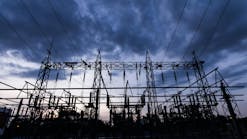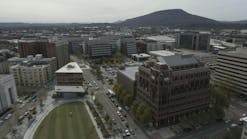Inspecting T&D towers and lines comes with added risk to crews, and the process can become complex when trying to get accurate measurements. Recently, thermal-equipped drones have gained traction as an effective tool for safely and efficiently inspecting T&D lines as well as their poles and towers — essentially every element of the power generation, transmission and distribution system. Standing up a drone program to inspect T&D infrastructure keeps crews safely on the ground and away from energized equipment, while also enabling them to complete inspections in a fraction of the time required for more traditional methods.
Crews can immediately assess equipment maintenance and replacement needs while keeping a safe distance. Then, once the inspection is complete, maintenance can begin to correct potential issues before a full breakdown causes a service disruption, saving time, money and customer frustration by identifying and fixing issues before they become failures.
“Utilities are using drones for lots of T&D applications,” said David Lee, a Level III thermographer and longtime commercial drone pilot. “They can find the small temperature differences that could turn into big problems without putting crews in helicopters or up the towers, and they can reach multiple towers from a single point of deployment, saving lots of time.”
Of course, using a thermal imaging-equipped drone for routine inspection is not as simple as flying a drone to the area of interest and capturing imagery. It requires specialized training to learn how to use the equipment most effectively while maintaining regulatory compliance. In addition, until recently, drone thermal inspections have had some practical limitations — data accuracy, flexibility and security among them — that are now being solved.
The Necessary Data
While drone inspections still are more efficient than manual inspections, the thermal sensors used on drones have not been optimized for taking quantitative temperature measurements the way handheld thermal cameras are, limiting them to more of a qualitative thermal-screening tool.
These two basic types of thermographic inspections — quantitative and qualitative — come down to whether the operator needs to get an accurate temperature measurement or just needs to find hot spots. One of the key factors required to get an accurate qualitative measurement is having enough pixels on target.
“To take an accurate, quantitative infrared measurement, you need to satisfy the camera’s spot size ratio,” Lee noted. “It’s vitally important to getting an accurate measurement because it’s one of the few things you can’t change in the software — either you’ve got enough pixels on target or you don’t and you have to retake the image.”
For a variety of reasons, thermographic cameras cannot get a reliable measurement from a single pixel; they need a collection of them. How many pixels varies depending on the camera model, but on the Teledyne FLIR SIRAS, for example, it is a square of multiple pixels.
Dedicated thermography cameras have a reticle displayed on the screen that shows the square of pixels required to attain an accurate measurement. When the target fills the reticle, it is close enough to the camera to capture an accurate measurement. In the past, drone thermal cameras have been missing this vital piece of information, requiring operators to guess how close they need to get to their target and when they have achieved that distance. Modern platforms can provide that information in flight to attain more accurate measurements.
“Having a visible representation of your spot size relative to your target in real time on a drone is a game changer, and really helps make SIRAS a quantitative measurement drone platform,” Lee explained. “Many drones have a crosshair representing a single pixel, but it’s not providing an accurate temperature measurement.”
This method can rapidly improve efficiency, as it eliminates the need for additional crew members to quantify the severity of a given problem through other more traditional methods, all while improving safety.
When And Where
One of the major challenges of inspecting critical infrastructure, like utility assets, is securing the technology, training and regulatory approval to easily inspect such sensitive infrastructure. Regulators face a challenging dilemma in terms of safely and efficiently integrating unmanned aircraft system (UAS) operations into their respective national airspace systems and enforcing compliance with relevant regulations, including the enforcement of no-fly zones around sensitive areas, such as utility infrastructure.
Many drone manufacturers created geo-fencing systems to keep their drones from flying in sensitive places, from airports to power plants. Geo-fencing uses the drone’s GPS location to determine whether it is inside a geo-fenced area and locks the pilot out from flying if the drone is determined to be in an unauthorized location. While geo-fencing seems like a good idea on the surface, it creates complications and challenges for utility operators. Power generation, transmission and distribution facilities often are considered critical infrastructure and can be included in a drone’s geo-fenced restrictions. These geo-fences apply to everyone equally — even the utility operators who need to inspect these components to keep the power grid functioning. Those same utilities often must secure additional approval to simply fly within their own geographical footprint.
Allowing operators to fly when and where the mission demands is critical to utility operations. The new SIRAS does not use geo-fencing. Professional drone pilots can fly without the added complication of the drone’s firmware keeping them on the ground because the manufacturer assumes the pilot is not authorized to fly in certain locations. It also places the responsibility to fly in legal airspace with the pilot. This enables utility drone pilots to inspect the towers and components they need to — especially critical during an emergency when seconds and minutes matter.
In support of such efforts, the U.S. House of Representatives recently passed a bipartisan bill to help state, local and tribal governments use drones to visually inspect critical infrastructure. H.R. 5315, the Drone Infrastructure Inspection Grant Act, would provide US$100 million in grants for local governments to purchase drones or contract for services to inspect critical infrastructure and help to ease the nation’s serious inspection backlog. Another $100 million is earmarked for training the next-generation workforce on the use of this technology. A companion bill in the U.S. Senate also is under consideration to help convert the legislation into law.
Providing Data Privacy
In the interest of national security, industrial drones also are doing away with cloud data connections, reducing the entry points for would-be hackers to access sensitive data about utilities, such as a nuclear power plant or critical substation.
Drones like the Teledyne FLIR SIRAS maintain data privacy by only storing data to an on-board SD card, so pilots do not have to worry about data being sent to other places or organizations without their knowledge. By not including transmission capabilities other than the necessary control and video signals sent between the airframe and the controller (or to comply with the Federal Aviation Administration’s Remote ID rules), utilities and inspectors can have peace of mind that data will be more secure.
A New Era
Thanks to advances in technology and policy, along with a renewed focus on data privacy and security, leveraging thermal-equipped drones for completing critical utility inspections is more viable than ever before.
Improved equipment capabilities reduce inspection time while improving safety. In turn, industrial-grade drones also are making the use of drones for utility inspection easier to operate while providing improved data privacy. Meanwhile, governments around the world, including the U.S. federal government, recognize the value of drone-based critical infrastructure inspection for national interests. They are providing more resources and funds to encourage the use of drones today and for generations to come.
For utilities that have not explored drone thermal inspections yet, now is the time.
Kelly Brodbeck is a product management executive with experience in multiple technical industries including thermal imaging, photonics, energy development and operations, and medical device. He is currently charged with advancing Teledyne FLIRs commercial UAS product offerings to serve a broader portion of the market with new payloads, airframes, and software.


